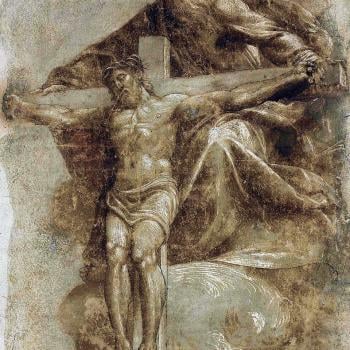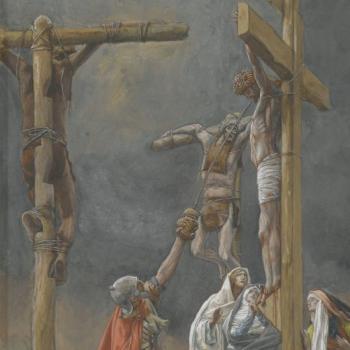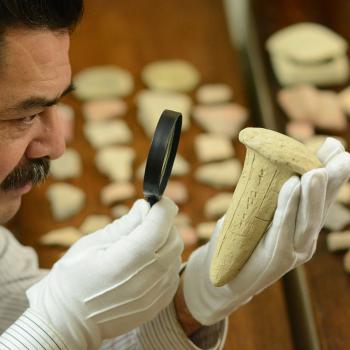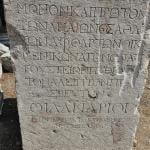Bethlehem is “a place where extremes meet.” So wrote GK Chesterton in a meditation on Christmas. Here is the immediate context of his statement:
It has been created in our minds by Christmas because we are Christians; because we are psychological Christians even when we are not theological ones. In other words, this combination of ideas has emphatically, in the much disputed phrase, altered human nature. There is really a difference between the man who knows it and the man who does not. It may not be a difference of moral worth; but it is a plain fact about the crossing of two particular lights, the conjunction of two stars in our particular horoscope. Omnipotence and impotence, or divinity and infancy, do definitely make a sort of epigram which a million repetitions cannot turn into a platitude. It is not unreasonable to call it unique. Bethlehem is emphatically a place where extremes meet.
As Chesterton writes, “omnipotence and impotence,” “divinity and infancy” meet there. In Chesterton’s mind, Bethlehem is utterly unique. He reflects further on Bethlehem and its peculiarity and centrality in the Christmas story:
No other story, no pagan legend or philosophical anecdote or historical event, does in fact affect any of us with that peculiar and even poignant impression produced on us by the word Bethlehem. No other birth of a god or childhood of a sage seems to us to be Christmas or anything like Christmas. The truth is that there is a quite peculiar and individual character about the hold of this story on human nature; it is not in its psychological substance at all like a mere legend or the life of a great man. It does not exactly in the ordinary sense turn our minds to greatness; to those extensions and exaggerations of humanity which are turned into gods and heroes, even by the healthiest sort of hero worship. It does not exactly work outwards, adventourously, to the wonders to be found at the ends of the earth. It is rather something that surprises us from behind, from the hidden and personal part of our being; like that which can sometimes take us off our guard in the pathos of small objects or the blind pieties of the poor. It is rather as if a man had found an inner room in the very heart of his own house, which he had never suspected; and seen a light from within.
Chesterton writes that no pagan legend affects us the way Bethlehem with its various historical peculiarities does. The canonical gospels from which the story of Jesus’ birth in Bethlehem stand out are singular in their character, according to literary critic C.S. Lewis. And yet, there is certainly overlap. How can it be otherwise, when the gospel story is a myth that is also a historical event? The official site for C.S. Lewis provides the following selection from Lewis’s comparison of the Christian story and pagan myths:
“The heart of Christianity is a myth which is also a fact,” he says in an essay titled “Myth Became Fact”. “The old myth of the Dying God, without ceasing to be myth, comes down from the heaven of legend and imagination to the earth of history. It happens—at a particular date, in a particular place, followed by definable historical consequences. We pass from a Balder or an Osiris, dying nobody knows when or where, to a historical Person crucified (it is all in order) under Pontius Pilate. By becoming fact it does not cease to be myth: that is the miracle. …God is more than a god, not less: Christ is more than Balder, not less. We must not be ashamed of the mythical radiance resting on our theology. We must not be nervous about ‘parallels’ and ‘Pagan Christs’: they ought to be there—it would be a stumbling block if they weren’t.”
The New Testament gospel accounts, including the birth narratives of Jesus, speak deeply to me. I get lost and am found in the wonder of how mythical universality and historical particularity, sheer transcendence and granular immanence, omnipotence and impotence come together—from the cradle to the cross and beyond the grave. Bethlehem, Golgotha, and the empty Garden Tomb are where we find Jesus, who is Bethel—where God dwells. He is the “place where extremes meet.”
Let’s turn back to Bethlehem for a moment. It appears to have a long history of being a place where extreme things happen. The great King David of Israel comes from little and lowly Bethlehem in Judea. It is where Jesus is born and where Roman-appointed King Herod orders a massacre of boys two years old and younger in his insane rage to try and destroy the Christ child. It is not only a place where the Jews struggled to survive under Roman and Herodian rule, but also where Palestinians, including Palestinian Christians, struggle to endure today (Refer here, too).
Maybe you, too, are struggling to survive, struggling to endure, this Christmas. Maybe you, too, take comfort from the fact that Bethlehem is the place where extremes meet. I certainly take comfort from this fact today in the Pacific Northwest far away from the Middle East.
Last night, I sat at my twenty-seven-year-old son Christopher’s bedside in his adult care facility. Christmas music played on the radio. Suddenly and to my surprise, I broke down in tears. It had been such an exhausting day and night and I did not have the strength to hold back the extreme emotions. I told my son how sad and grieved I was for him amid all that had happened to him. The catastrophic brain injury he endured nearly two years ago has turned all our lives upside down and left my son alone in a room much of the time, even on Christmas Eve night. The incident and aftermath threaten to undo us.
To my surprise, Christopher slowly moved his right arm toward me, as if he wished to hold my hand and comfort his dad. I couldn’t believe it. So many days and nights, I try to get him to move his arms toward me. Sometimes he moves his right arm toward me. Many times, he doesn’t. But now, without prompting, he moved that right arm to cross the seemingly boundless chasm between his body and mine, a mere two feet apart. He was looking intently at me.
I grasped Christopher’s hand with my two hands and thanked him for reaching out to me. Talk about extreme emotions. I went from dejection to jubilation, as our hands and hearts met. I told Christopher again and again how much we love him, and that I would return on Christmas Day. I wiped away the tears before saying goodnight, then returned home in the deep darkness amid the icy rain that fell outside.
The extreme emotions did not end there but followed me home and then to bed. So, too, did the gaze of the God who shows up in extreme places—God with us Immanuel. Like Bethlehem of his birth, Jesus is the place where extremes meet.
May you and I take comfort from “the myth which is also a fact,” from the place where mythical universality and historical particularity, sheer transcendence and granular immanence, omnipotence and impotence meet. Bethlehem’s baby born there over two millennia ago holds these extremes together in his person. If he can unite these unimaginable tensions, surely, he can hold our extreme emotions together and hold us up when we cannot keep our lives together. Like Bethlehem, Jesus “is emphatically a place where extremes meet.”












